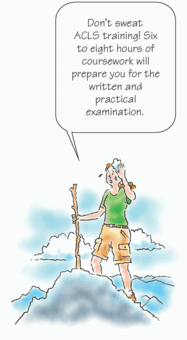ACLS Essentials
 Just the facts
Just the factsIn this chapter, you’ll learn:
♦ core concepts of advanced cardiac life support (ACLS)
♦ basic components of the ACLS course
♦ study strategies to help you prepare for the ACLS examination.
What is ACLS?
Advanced cardiac life support (ACLS) is a systematic approach to resuscitation efforts. ACLS training gives rescuers a coordinated way to approach critically ill patients, regardless of response team size. (See ACLS core concepts, page 2.)
Health care workers seeking ACLS training include physicians, registered nurses (RNs), advanced emergency medical services (EMS) personnel, and dental and surgical care professionals.
|
ACLS training
The foundation of ACLS is high-quality basic life support (BLS). A current BLS card is required of ACLS training participants.
The ACLS card is granted after a person successfully finishes an initial 2-day course or an 8-hour recertification course. The course involves lectures on ACLS concepts and hands-on practice using simulated ACLS situations, followed by a written and practical examination. Certification cards are issued only to active healthcare providers with the appropriate skills and knowledge to participate in ACLS.
Keep in mind that the completion card, which verifies that you’ve successfully completed the course, isn’t a license
to perform techniques discussed or reviewed in the course (such as endotracheal intubation or I.V. catheterization). Instead, each person’s scope of practice and state license determines her ability to perform these techniques. ACLS renewal is required every 2 years.
to perform techniques discussed or reviewed in the course (such as endotracheal intubation or I.V. catheterization). Instead, each person’s scope of practice and state license determines her ability to perform these techniques. ACLS renewal is required every 2 years.
ACLS core concepts
Here are the core concepts and skills you’ll need for advanced cardiac life support (ACLS) training.
General skills
For all devices and procedures, you should know:
indications
precautions
proper use.
For every medication, you should know:
why to use it
when to use it
how to administer it
what to watch for.
Airway management
You should know how to perform and assist with endotracheal intubation. You should also know alternative ventilation techniques, such as how to use a bagvalve mask device and laryngeal mask airway.
Early management
You should know how to manage the first 30 minutes of emergencies that result from such causes as:
acute coronary syndrome
cardiac arrest associated with trauma
cardiac arrest involving a pregnant patient cardiac tamponade
drowning and near-drowning electrocution and lightning strike
hypothermia
pneumothorax possible drug overdose
stroke thrombosis.
Electrical therapy
You should know how to safely use electrical devices, such as an automated external defibrillator, conventional defibrillator, and pacemakers.
Emergency conditions
You should be able to identify indications for ACLS, such as asystole, pulseless electrical activity, supraventricular tachycardias, ventricular tachycardia, and ventricular fibrillation. You should also be able to institute proper treatment for the identified indication quickly.
I.V. and invasive techniques
You should be familiar with I.V. and invasive therapeutic techniques, such as peripheral and central I.V. line insertion and intraosseous cannulation.
Pharmacology
You should know the action, indication, dosages, and precautions for the major drugs used during ACLS, such as adenosine, amiodarone, and epinephrine.
Online possibilities
Born to teach
After completing your course, if you show exemplary understanding of the core concepts and you’re interested in teaching an ACLS course, you can follow the formal process to become an ACLS instructor.




